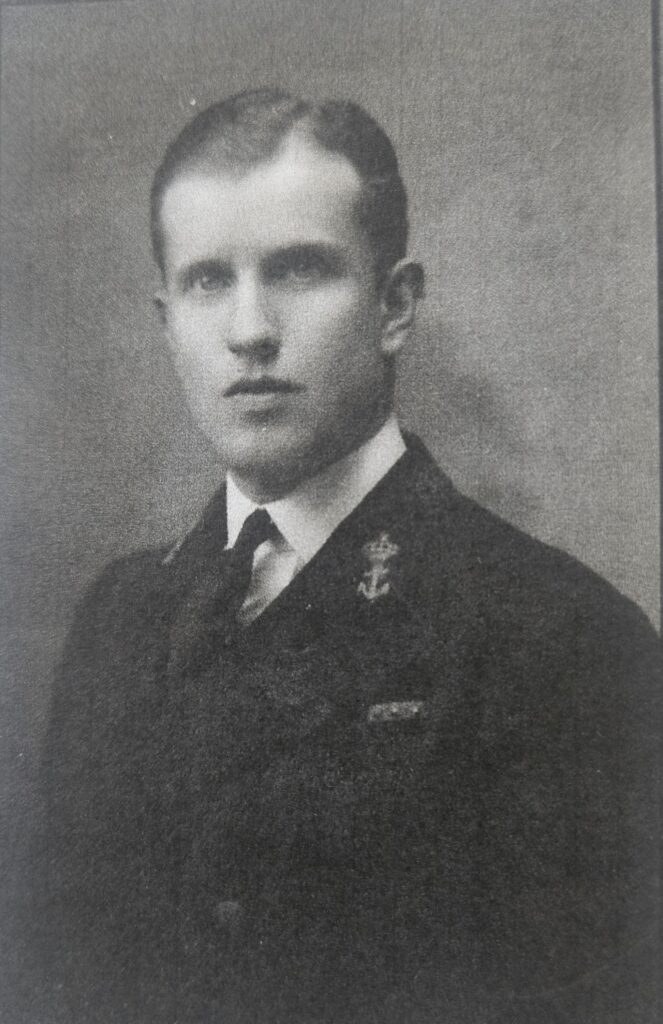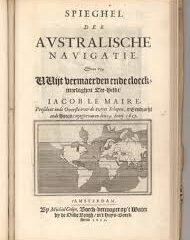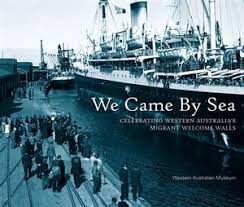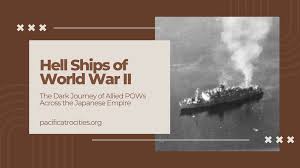Early life in Amsterdam

Early life in the Netherlands
Pieter Robert (Robby) Boele van Hensbroek was born in Amsterdam on 18 October 1920 to André Boele van Hensbroek and Jo Sluiter. He grew up with his sister Elsje in a close-knit family. His youth was marked both by joyful summers with his cousins at the Sluiter family retreat in Elspeet and by the hardships of the Great Depression. When his father lost his job in 1930, the family had to move in with his grandmother, but despite these difficulties, Robby always remembered his childhood fondly: cycling holidays, museum visits, hockey and tennis, and above all, his fascination with visiting Dutch warships in Amsterdam.
This fascination proved decisive: in September 1938, he entered the Royal Netherlands Navy as a midshipman (adelborst). Of his class of 27, only six would survive the Second World War. That survival — and the loss of so many of his peers — shaped his sense of duty and moral responsibility for the rest of his life.
Wartime service
Boele’s naval career began at the moment of national crisis. In May 1940, when Germany invaded the Netherlands, he was swept up in the chaos of defeat and escape. He was among those who fled to England aboard the torpedo boat Hr.Ms. Z7, entrusted with carrying the naval cadet corps banner. The small group was warmly received in Dover and later re-equipped in Portsmouth, where the Dutch cadets marched behind Royal Navy bands through London.
Soon after, he served aboard Hr.Ms. Jacob van Heemskerk, escorting Hr.Ms. Sumatra as it carried Princess Juliana and her daughters Beatrix and Irene to safety in Canada. The cadets then transferred to Sumatra and operated with the Royal Navy in the Caribbean, patrolling against German raiders. From Jamaica to Curaçao and on to Cape Town, they experienced both the thrill of coalition operations and the sobering lessons of colonial societies marked by harsh segregation.
In September 1941, Boele joined Hr.Ms. Tromp, the only major Dutch warship to survive the Japanese onslaught. Tromp fought bravely in the waters around Java and Bali before retreating to Australia for repairs in 1942. From that moment, Australia became a key base for Boele and his fellow officers. He later reflected that the survival of Tromp — and his own presence aboard her — was a turning point that bound his life to Australia.
Returning to the Indies and the road to independence
In June 1941, Boele was commissioned as a sub-lieutenant. By the end of the war, he commanded a minesweeper engaged in clearing Japanese mines from harbours in Surabaya, Makassar and elsewhere. It was during this work, in May 1946, that he met his future wife Wilhelmina (Mieneke) Hissink, a nurse serving on the Dutch hospital ship Oranje. They married in Amsterdam in February 1947 and began their family in Den Helder, where their first children, May and Andrew, were born.
But the political situation weighed heavily on him. Boele could not reconcile himself with what he saw as the moral failure of the Dutch government in abandoning Indonesians who had trusted Dutch promises of reform. On 28 February 1951, he resigned his commission, determined to build a new life elsewhere.
Migration to Australia
On 4 March 1951, just eight days after leaving the navy, Robby, Mieneke, and their two young children boarded a plane to Australia. For them, migration was both an adventure and an act of principle: leaving behind the uncertainty of a Europe scarred by war and colonial collapse, they sought a country of hope and opportunity.
Their early years were not easy. They built a prefabricated house at Frenchs Forest on Sydney’s outskirts, only to lose all their possessions in a bushfire that destroyed their garage. Yet they refused to complain — hardship was accepted as part of life’s journey. Robby found work with a Dutch dredging company maintaining Newcastle harbour, before moving his young family westward to Perth in 1953.
In Western Australia, Robby and Mieneke built a home on a small property at Forrestdale. There they began a building company that grew rapidly before being sold in 1960. Robby then co-founded a building society that became the Home Building Society, today one of WA’s largest. Alongside this, he explored ventures in finance and real estate.
His emigration memories show both resilience and humour. He often recalled how Dutch migrants had to adapt quickly to Australian ways, relying on initiative, hard work, and community support. For him, the lesson was that discipline and activity — the same principles that kept morale afloat at sea — were equally vital in civilian life. As he told younger generations: “When the going gets tough, the tough get going.”
Ventures and vision
The 1960s brought both personal challenges and new ambitions. Robby briefly pursued plans to help develop West Papua, but these ended when the territory was handed to Indonesia in 1961, a political decision he never accepted. After a difficult financial period, he turned to forestry. In 1972 he helped establish Australasian Pines Pty Ltd, a forestry company financed by partnerships with the public. By 1974, the enterprise expanded to Queensland, leading the family to move east.
There he became the driving force behind a 2,000-block forestry subdivision at Glenwood, north of Brisbane, and helped establish the Brisbane Investment Group, specialising in agro-forestry and finance. He retired as chairman in 1986, passing the business to his sons but remaining active as mentor and adviser.
Life in Queensland
From their Cape Dutch–style house “Welkom” in Brookfield, Robby and Mieneke built a family life that was warm, open, and generous. Their home was always full of children, friends, and visitors. They raised five children — May, Andrew, Katie, Emma, and Martyn — and despite hardships, ensured that each received a private education and the opportunity to attend university. The tragic loss of their infant daughter Richarda in 1958 marked their deepest sorrow, but they faced it with resilience and faith.
Robby loved horses and tennis, playing well into his later years, and he relished gathering his twelve grandchildren at family reunions. His life was one of enterprise, energy, and joy — but above all, of moral principle. Whether resigning from the navy, taking risks as a migrant, or championing ventures in forestry and finance, his choices were guided by what he felt was right.
Community engagement
Beyond his business achievements, Robby remained engaged with the Dutch community in Australia. He was involved with the Netherlands Ex-Servicemen and Women’s Association (NESWA) in Queensland and wrote articles and opinion pieces reflecting on the war in the Indies and the path to Indonesian independence. His voice — at once critical, reflective, and proud of Dutch naval traditions — added to the memory of the wartime generation.
Conclusion
The life of Pieter Robert (Robby) Boele van Hensbroek spanned continents and eras: from Amsterdam to Surabaya, from wartime England to the battlefields of the Indies, from Sydney’s bushfires to the pine plantations of Queensland. His story embodies the resilience of a generation that endured war, exile, and the loss of empire, yet built new lives in a distant land.
For the Dutch in Australia, his legacy lies not only in his business achievements and community service, but also in the values he passed on: discipline, resilience, and moral courage. His own words capture this enduring spirit: “Wie wil, wint – who dares, wins.”
Archive Pieter Robert Boele van Hensbroek (at the DACC)
Articles selected from the archive
We start with English abstracts of the Dutch articles, with full articles in the pdf.
Dutch naval cadet experiences with Australia in WWII – Published in KIM SPIEGEL -Koninklijk Instituut voor de Marine – 1996
P.H. Boele van Hensbroek, later a Dutch naval officer, shared in 1996 his memories as an adelborst (midshipman) during the outbreak of the Second World War. His account is wide-ranging, but several points touch directly or indirectly on Australia and Dutch–Australian wartime links.
A central theme in his reflection is the Dutch sense in 1940 that the war could still be won because the Netherlands was part of a wider kingdom: with Suriname, the Antilles, and above all the Netherlands East Indies (NEI). For young naval men, the Indies were the heart of the Dutch global presence, and the navy’s responsibility extended across oceans. From the beginning, Japan was identified as the likely enemy, and Australia inevitably loomed in strategic calculations, as the nearest continental ally in the Pacific.
Boele describes how, after the fall of the Netherlands, Dutch officers and cadets reached England, and later were deployed across the empire. Their naval service took them first to the West Indies, then down the African coast to South Africa, and eventually on to the Netherlands East Indies. Along this route, he observed stark contrasts between British colonies and Dutch territories. The harsh racial segregation in British colonies stood out to him, compared with the more mixed societies under Dutch administration. This contrast would later colour Dutch perceptions of Australia as well, with its White Australia policy and sharp racial boundaries — a theme that would complicate Dutch–Australian wartime cooperation when thousands of Dutch forces and officials were based in Brisbane from 1942.
In his broader reflections on discipline, morale, and adaptation to difficult times, Boele offered lessons he considered timeless. He even quoted a saying familiar in Australia: “When the going gets tough, the tough get going.” For him, this Australian expression summed up the resilience needed to maintain discipline and purpose in war and in life.
Finally, his service in the NEI often brought him close to Australia as a theatre of operations. Dutch ships such as Hr.Ms. Tromp and others operated through the eastern archipelago, in waters adjoining northern Australia. The naval strategy, built around limited resources, expected that the Dutch would delay Japanese expansion until the larger Allied powers — Britain, the United States, and crucially Australia — could provide reinforcements. This strategic vision placed Australia and the NEI on the same front line of the Pacific War, long before the Japanese advance made that a reality.
Het rapport Visman (commissie-Visman, 1941) – Published in Marineblad 1995/96
This essay explains P. R. Boele van Hensbroek’s view that the Netherlands’ post-war course for the Netherlands East Indies (NEI) should be read through the lens of the 1941 Visman Report. He argues the report—compiled by a mixed commission of Indonesians, Dutch and a Chinese member after extensive hearings with 147 groups—showed broad support for continued association with the Netherlands within a reformed “Kingdom in a new style”. In his reading, most groups sought a federal Indonesia (to prevent Javanese dominance), progressive removal of discrimination, and shared “realm” institutions for defence, foreign affairs, shipping and the economy.
He contrasts these plans with the turmoil of 1945–49. In his account, Dutch military presence was intended to restore security and allow Indonesia’s diverse peoples to determine their future free of intimidation after the Japanese occupation. He also contends that Allied great-power interests—particularly British and Australian calculations and, later, UN dynamics—undermined Dutch-Indonesian federal plans, sidelining Visman’s framework. Boele’s conclusion is that the Netherlands’ intentions were “verantwoord en eerbaar” (responsible and honourable), and that Dutch public discourse should not be governed by a guilt complex. The Marineblad editors published the piece as a contribution to debate, while noting concerns about selectivity of sources and a strongly Netherlands-centred perspective.
Het Nederlandse optreden in Indonesië 1945–1949: verantwoord en eerbaar
In this companion article Boele develops the Visman-based thesis across the chronology of 1945–49. He highlights pre-war developmental gains (education, health, agriculture and industry) as the platform for federal self-government; summarises Visman’s consensus for a states-union with the Netherlands; and argues that Dutch policy from 1945 aimed to convene a realm conference once order and economic recovery were restored. He maintains that the first and second “police actions” were conceived to protect non-Javanese regions and federal states from coercion, and that the Round Table Conference’s outcome—the United States of Indonesia—matched Visman’s federal logic until it was rapidly dissolved by force.
The essay is deliberately polemical: it claims Allied decisions in 1945–46 prevented timely Dutch landings, advantaged the republican leadership diplomatically, and framed the conflict internationally in ways that made a negotiated federal outcome untenable. A Marineblad editorial afterword (1995) acknowledges the article’s resonance for a generation of veterans but counters key points: it disputes Visman as a policy blueprint, emphasises the decisive impact of the Japanese occupation and republican revolution, notes the limits of Dutch capacity in 1945, and cautions against reading complex decolonisation through a single report.
De strijd in Nederlands-Indië 1941–1942 Marineblad March 1995
This operational study argues that the fall of the NEI cannot be reduced to Dutch military failure. Drawing on Dr Jack Ford’s “Duping the Dutch” thesis, Boele contends that Allied command arrangements (ABDA), the sidelining of Dutch local knowledge, and a series of British and American decisions materially worsened the position:
• command: creation of ABDA under Gen. Wavell and Air Cdr. Brereton marginalised Dutch commanders and severed the Navy’s control of its flying boats;
• lost opportunities: late or missing intelligence on invasion convoys; failure to commit “Blackforce” at Palembang; withdrawal of the Timor convoy; inadequate air cover for naval operations;
• squandered advantages: rejection of Dutch submarine innovations (snorkel/tactics) and ineffective US submarine torpedoes;
• operational consequences: the Battle of the Java Sea fought without adequate air support; subsequent withdrawals that forfeited chances to attrit invasion fleets.
He stresses Dutch endurance relative to Malaya/Singapore and the disproportionate damage inflicted by Dutch naval and air units in late 1941–early 1942. The piece prompted a robust exchange in Marineblad (1995–96): supporters urged a reassessment of Allied decisions; critics argued that Dutch rearmament and doctrine were already insufficient, that ABDA’s priorities reflected hard strategic constraints, and that focusing on missed Allied support underplays the structural imbalance and the revolutionary context on Java.
Other Publications from the archive
Experiences of P.R. Boele van Hensbroek, Naval Cadet Class of 1938.
In this 1996 reminiscence, Pieter Robert (Robby) Boele van Hensbroek recalls his experiences as a Dutch naval cadet (adelborst) of the class of 1938 during the dramatic years of 1940–42. He describes the shock of the German invasion, the escape of naval cadets aboard Hr.Ms. Z7 to England, and their early service alongside the Royal Navy escorting Princess Juliana to Canada and patrolling the Caribbean. His narrative highlights Dutch innovation in radar and anti-mine technology, the morale challenges of exile, and the importance of discipline in difficult times.
For Boele, the war was not the end but the beginning of a wider journey: from England to the West Indies, South Africa, and ultimately the Netherlands East Indies, where he joined Hr.Ms. Tromp. He situates these events in the broader outlook of the Dutch navy — that the kingdom extended far beyond Europe and that service in the Indies was both a responsibility and a fascination. His reflections also contain lessons for future generations on resilience, duty, and the enduring ties between the Netherlands, the Indies, and Australia.
The publication also contains extensive information on his emigration experiences.
The Experiences of a Naval Cadet during the War, 1940–1942
This lecture, delivered in Brisbane on 1 July 1996 by P.R. (Robby) Boele van Hensbroek, recounts his experiences as a Dutch naval cadet during the Second World War (1940–42). He reflects on the shock of the German invasion, his escape with fellow cadets to England aboard Hr.Ms. Z7, and their early service alongside the Royal Navy escorting Princess Juliana to Canada and patrolling in the Caribbean. He describes the morale challenges of exile, the importance of discipline in sustaining crews, and the formative lessons of coalition operations.
For Boele, these years forged lifelong convictions about resilience, duty, and the global reach of the Dutch navy. Speaking decades later from Australia, he linked his cadet experiences to values he carried into civilian and migrant life, offering younger generations enduring lessons from a turbulent era.
See also:
Dinner with Casey: Dutch divisions over West New Guinea – Some call it Treason.
The Dutch Consulate in Perth – 1950/1960
Australia and the Netherlands in WWII: alliance, mistrust, and betrayal


